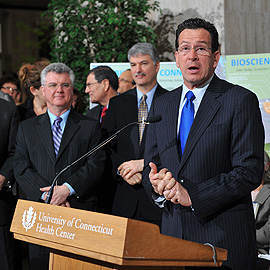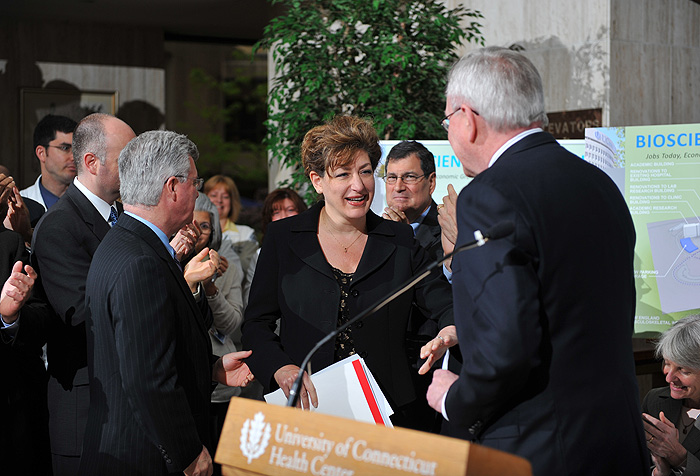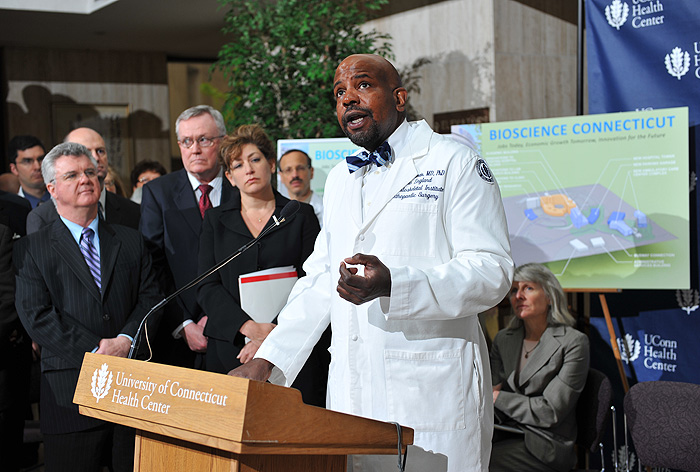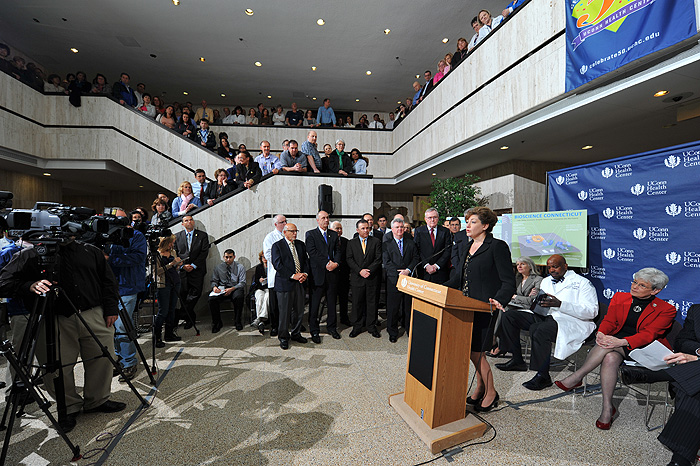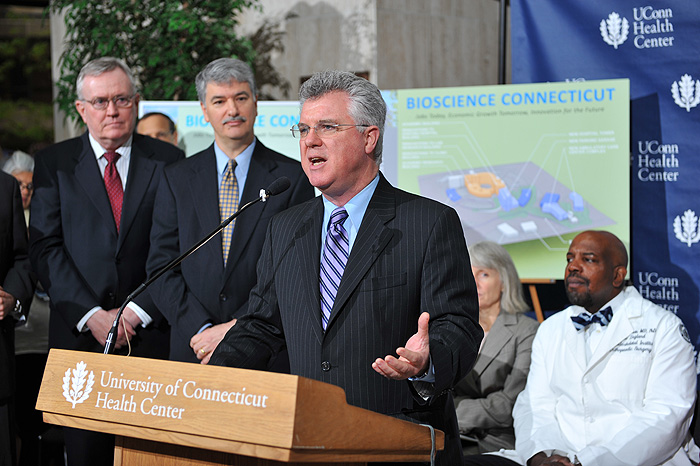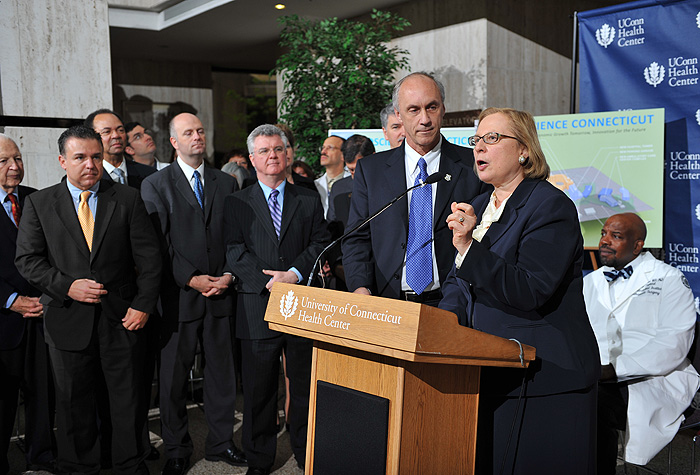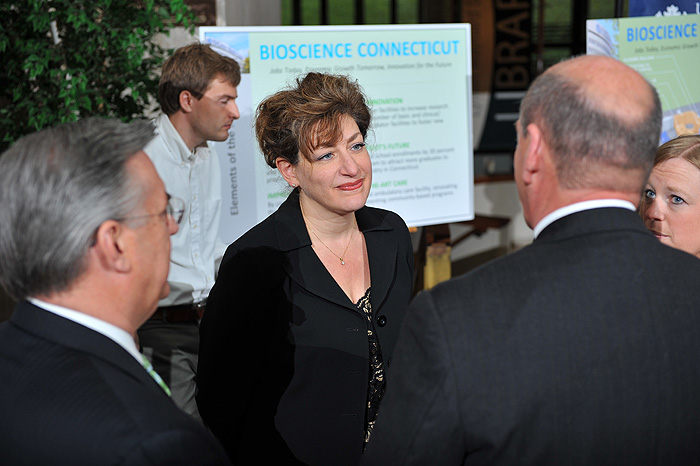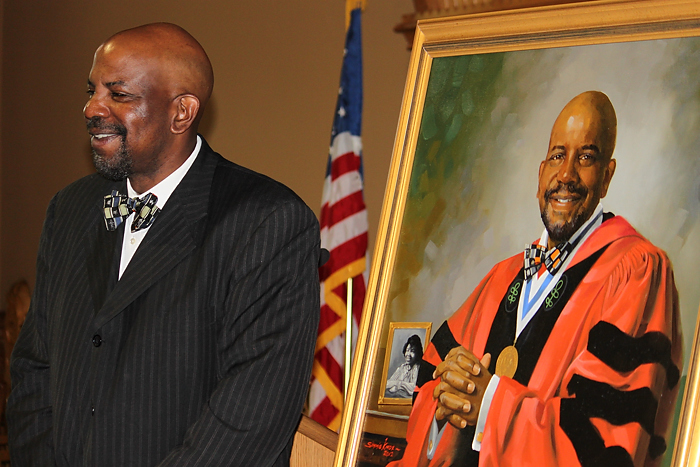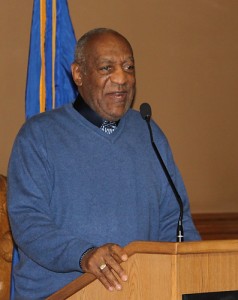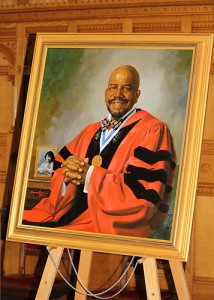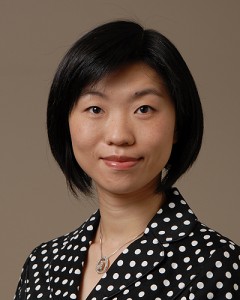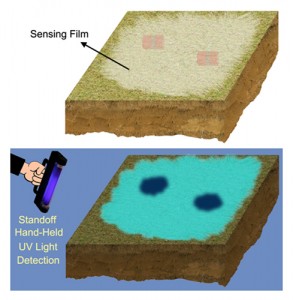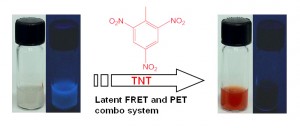 ChEg Assistant Professor Jeff McCutcheon on Membrane Technology and Water Purification. The School of Engineering has launched a short videotaped lecture about Jeff McCutcheon’s research. His work focuses on membrane systems and how these porous filters can utilize the ocean to solve the water crisis both for parched developing countries and for industries that rely heavily on water. Watch the video
ChEg Assistant Professor Jeff McCutcheon on Membrane Technology and Water Purification. The School of Engineering has launched a short videotaped lecture about Jeff McCutcheon’s research. His work focuses on membrane systems and how these porous filters can utilize the ocean to solve the water crisis both for parched developing countries and for industries that rely heavily on water. Watch the video
Year: 2012
Gov. Malloy Announces New Bioscience Connecticut Initiative
- May 17, 2011
- By: Carolyn Pennington, UConn Today
The Health Center is part of a new economic revitalization plan being proposed by Gov. Dannel P. Malloy. The Bioscience Connecticut initiative aims to make the state a leader in bioscience research and in turn, jumpstart the state’s economy by creating jobs and generating long-term economic growth.
“This proposal represents a new way of thinking about the UConn Health Center and the way in which it can be leveraged to create new jobs now, sustain economic growth and innovation, and improve public health,” said Malloy. “More than just a medical and dental school or just a hospital – we have to think about the UConn Health Center in its entirety, as an asset that can make Connecticut become a national leader in a bioscience economy.”
Highlights of Malloy’s proposal include:
- Creating 3,000 construction jobs annually through 2018.
- Generating $4.6 billion increase in personal income by 2037, including the creation of 16,400 jobs.
- Doubling federal and industry research grants to drive discovery, innovation, and commercialization.
- Increasing access to high quality health care.
- Graduating and retaining more physicians and dentists to meet forecasted workforce needs resulting from health care reform and the state’s aging population.
- Strengthening and stabilizing the Health Center’s finances.
President designate Susan Herbst is introduced at the press conference. Photo by Peter Morenus
“Bioscience Connecticut is different from prior proposals that involved the Health Center,” said UConn President-designate Susan Herbst. “While they were principally intended to secure the Health Center’s financial footing, this initiative is primarily focused on using the Health Center to achieve state economic and health care objectives.”
The initiative also seeks to address the growing shortage of physicians and dentists being predicted in the years ahead.
“By training more physicians and dentists, the Governor’s plan responds to these dire trends,” said Dr. Cato T. Laurencin, vice president for health affairs and medical school dean. “The increased enrollment, combined with other elements of Bioscience Connecticut, is expected to raise our schools into top tier, national status. In turn, this will spur economic growth and lasting public health benefits for our state.”
For the Health Center, key components of the plan include:
Dr. Cato Laurencin, vice president for health affairs, speaks at the press conference. Photo by Peter Morenus
- Renovating existing Health Center facilities to increase bioscience research capacity and productivity, increasing the number of basic and clinical/translational scientists, and expanding small business incubator facilities to foster new business start-ups.
- Increasing the Health Center’s medical and dental schools’ enrollment by 30 percent, and establish a loan forgiveness program to attract more graduates to practice primary care medicine and dentistry in Connecticut.
- Constructing the new patient tower and a new ambulatory care facility, and increasing the number of Health Center primary and specialty care clinicians.
The $864 million proposal will be paid for by a combination of new and previously approved bonding, private financing, and Health Center resources.
President-designate Susan Herbst speaks at the press conference held at the UConn Health Center to announce Bioscience Connecticut. Photo by Peter Morenus
House Majority Leader Christopher Donovan (D-Meriden) speaks as, from left, President Philip Austin, Senate President Don Williams, and Dr. Cato Laurencin, seated, look on. Photo by Peter Morenus
State Sen. Terry Gerratana (D-New Britain) speaks, as State Rep. Bill Wadsworth (R- Farmington), center, looks on. Photo by Peter Morenus
President-designate Susan Herbst meets with legislators after the press conference. Photo by Peter Morenus
CPTV Films in Dr. Parnas’ Biodiesel Lab
- Republished with permission of emagination, a School of Engineering electronic publication
Dr. Richard Parnas, director of the University’s Biofuel Consortium, hosted a film crew from Connecticut Public Television (CPTV) in April. The CPTV crew interviewed Dr. Parnas and filmed the production of biodiesel from waste vegetable oil as part of a segment on green technologies to be aired during the summer. It’s just one of many recent “tech props” Dr. Parnas has received for his innovative biofuels research.
Dr. Parnas and his team garnered significant press coverage in 2010 for a limited study showing that industrial grade hemp-based biodiesel has superior cold flow properties versus those of many biodiesel mixtures. Cold temperature is the major issue requiring caution when using biodiesel. Dr. Parnas, a professor in the Chemical, Materials & Biomolecular Engineering Department (CMBE) and the Institute of Materials Science (IMS) at UConn, has championed biofuels as a green energy source for years. Biofuels are extremely attractive as an alternative transportation fuel because they produce very little in the way of ozone-depleting emissions, in contrast with fossil fuels.
Within the warren of interconnected spaces that make up his basement laboratory in the Engineering II building on the main Storrs campus, Dr. Parnas has spent four years improving upon a basic biodiesel reactor design with the objectives of increasing production capacity and enhancing efficiency. The lab features two reactors: the oldest, smaller of the two units is used in the ongoing waste cooking oil-to-biodiesel production operation; the second, which features unique design enhancements developed by Dr. Parnas, is used for research and testing. A YouTube video of the reactor may be viewed here.
Since 2005, Dr. Parnas estimates 25 undergraduate students have worked in the laboratory, processing waste cooking oil collected from UConn’s dining facilities and from Pratt & Whitney’s food service into clean biodiesel that is used to help fuel UConn’s bus fleet. The students do more than merely combine oil and chemicals, however; working with Dr. Parnas and his graduate students, they have also contributed to a numerical model that accurately mirrors the entire process on a computer screen, using data collected in real time. The model enables the team to monitor each step of the process and to make adjustments as needed for optimal performance.
Dr. Parnas and two partners, Fred Robson and Rich Madrak, recently formed a startup company called RPM Sustainable Technologies. It will commercially market a novel, patented reactor system designed by Dr. Parnas, which features a number of unique process improvements over the traditional reactor design and reduces production costs. The partners have commissioned an industrial equipment manufacturer to build the systems, which will be scaled-up versions capable of serving communities and processing between 250,000 and 5 million gallons of biodiesel yearly. The first unit will be delivered this summer to UConn.
In most traditional reactors, the process is conducted in a batch mode. The biodiesel is separated in one stream while waste products left over from processing – glycerol, methanol and potassium hydroxide – are removed in a second stream that must be further separated and processed for re-use. In Dr. Parnas’ patented design, biodiesel is processed continuously and the glycerol settles out naturally during processing. Continuous processing is more efficient, requires less energy than conventional reactors, and lowers production and material costs. Furthermore, Dr. Parnas’ reactor design efficiently captures the byproducts so they may be further processed for secondary markets. He notes that the glycerin will be sold to the personal care products market or converted to high value specialty chemicals, and the potassium hydroxide may be blended with phosphoric acid to produce fertilizer.
While biodiesel holds promise for replacing fossil fuels in applications such as transportation and home heating, the mixtures suffer from several drawbacks. For one thing, biodiesels generally perform poorly in cold weather, becoming thick and clogging fuel systems. For this reason, biodiesel is currently blended with conventional diesel fuel – commonly at 20 percent biodiesel to 80 percent conventional (so-called B20) for automotive use. Because biodiesel requires feedstocks that are fundamentally plant matter, abundance and growing conditions are a factor. Furthermore, to be approved for vehicular use, biodiesel must meet ASTM International’s rigorous industry standards. Samples of the UConn biodiesel are subjected to a battery of 16-18 validation tests conducted in a CESE laboratory building.
Research into alternative feedstocks is an important aspect of the team’s work. With his faculty colleagues and graduate students, in addition to exploring industrial hemp, Dr. Parnas is studying cotton seed oils and Jatropha oil, among other possibilities. Jatropha, he explains, is a waste cover crop native to India that produces the second highest oil yield, at approximately 34 percent oil, of any land plant and grows readily in even unfavorable conditions. Already, the handsome succulent is being commercially processed into biodiesel in India, Myanmar and Brazil. According to Dr. Parnas, palm seeds offer the highest oil yield, but palms grow in a very narrow geographic band around the equator, so large-scale production is currently infeasible.
Dr. Parnas is also collaborating with Dr. Ranjan Srivastava, a colleague in CMBE, on the development of biobutanol as an alternative to gasoline. The project is in its earliest stages and entails more fundamental research. Whatever the outcome, in the years ahead it is clear that biofuels and biodiesel will gain even greater importance as the nation looks for ways to reduce its reliance on diminishing fossil fuel reserves.
Former Medical Dean Laurencin Lauded by Legislators, Friends and Colleagues
- May 9, 2012
- By: Maureen McGuire, UConn Today
Dr. Cato T. Laurencin’s official portrait was unveiled during a reception held at the State Capitol on May 9. (Sarah Turker/UConn Health Center Photo)
During a reception hosted by The Black and Puerto Rican Caucus of the General Assembly, the Health Center’s Dr. Cato T. Laurencin was honored not only for his service as vice president for health affairs and dean of the UConn School of Medicine, but also for being an outstanding role model and inspiration to many.
Comedian Bill Cosby, a long time friend of Dr. Laurencin, attended the reception held at the State Capitol. (Sarah Turker/UConn Health Center Photo)
“How proud I am to be here,” said Laurencin’s longtime friend, comedian and activist, Bill Cosby. Though they graduated many years apart, their common bond is Central High School in Philadelphia.
Cosby stressed that it is important for students in their high school today — “our kids” — to see what can be achieved. Further, he urged all in attendance to reach out to children and teens to help them understand career choices and follow in the steps of leaders like Laurencin.
Gov. Dannel P. Malloy, State Sen. Toni Harp, and Dr. Frank Torti, the Health Center’s executive vice president for health affairs and medical school dean, were among those who expressed their gratitude for Laurencin’s leadership and achievements.
Also during the reception, Laurencin’s official portrait was unveiled. It will soon hang in the hallway outside the Health Center’s administrative offices, along with the previous deans and leaders of the Health Center.
The portrait of Dr. Cato T. Laurencin will hang in the hallway outside the Health Center’s administrative offices. (Sarah Turker/UConn Health Center Photo)
Laurencin stepped down as vice president and dean last summer, following the final passage of Bioscience Connecticut, and has continued to focus on his roles as executive director of the Connecticut Institute for Clinical and Translational Science; director of the Institute for Regenerative Engineering; and clinically, as an orthopaedic surgeon with the New England Musculoskeletal Institute and holder of the Van Dusen Chair in Orthopaedic Surgery.
Among his many accolades, Laurencin’s research in the field of ACL regeneration was recently recognized by National Geographic magazine.
Improving the Detection of Landmines
- May 4, 2012
- By: Colin Poitras, UConn Today
Each year, as many as 25,000 people are maimed or killed by landmines around the world, including large numbers of civilians.
While landmines are inexpensive to produce – about $3-$30 each, depending on the model – finding and clearing them can cost as much as $1,000 per mine. It is a slow and deliberative process. Specially trained dogs are the gold standard, but they can be distracted by larger mine fields and eventually tire. Metal detectors are good, but they are often too sensitive, causing lengthy and expensive delays for the removal of an object that may turn out to be merely a buried tin can.
Ying Wang ’12 Ph.D. (Peter Morenus/UConn Photo)
A UConn chemical engineering doctoral student hopes to help. Ying Wang, working in conjunction with her advisor, associate professor Yu Lei, has developed a prototype portable sensing system that can be used to detect hidden explosives like landmines accurately, efficiently, and at little cost.
The key to the sensing system is an advanced chemically-treated film that, when applied to the ground and viewed under ultraviolet light, can detect even the slightest traces of explosive chemical vapor. If there is no explosive, the film retains a bright fluorescent color. If a landmine or other explosive device is present, a dark circle identifying the threat forms within minutes.
One of the world’s top private landmine clearing companies, located in South Sudan, is currently working with Lei and Wang in arranging a large-scale field test. The results of the field test could be of interest to the United Nations, which has worked to make war zones plagued by old landmines safer through its United Nations Mine Action Service. It is estimated that there are about 110 million active landmines lurking underground in 64 countries across the globe. The mines not only threaten people’s lives, they can paralyze communities by limiting the use of land for farming and roads for trade.
Detection of buried explosives. (Image courtesy of Ying Wang)
“Our initial results have been very promising,” says Wang, who receives her UConn Ph.D. May 5. “If the field test goes well, that is a real world application. I’m very excited about it.”
Doing work that has real world applications and that will help improve people’s lives is an important part of what drives Wang in her research.
“When I started working with landmines, I was thrilled,” says Wang, who received her bachelor’s degree in chemical engineering from Xiamen University in China in 2004 and her master’s degree in biochemical engineering from Xiamen University in 2007. “I knew this would be a really good application of our work. It can save lives.”
Wang and Lei are currently working with UConn’s Center for Science and Technology Commercialization (CSTC) in obtaining a U.S. patent for their explosive detection systems.
TNT detection in water. (Image courtesy of Ying Wang)
Besides the sensing method for explosives vapor, the pair has also developed a novel test for detecting TNT and other explosives in water. They recently presented their results at the 243rdNational Meeting & Exposition of the American Chemical Society (ACS) in San Diego, Calif. That research is also the subject of a U.S. provisional patent.
The latter application can be used to detect potential groundwater contamination in areas where explosives were used in construction. It can also be used in airports to help thwart possible terrorist threats.
Most airlines currently limit passengers to about 3 ounces of liquids or gels when boarding a plane because of the potential threat of carry-on explosives. That may change if Wang and Lei’s new sensing system is adopted. The pair have developed an ultrasensitive real-time sensor system that quickly detects both minute and large amounts of 2,4,6-trinitrotoluene or TNT. When searching for trace amounts of explosives, a paper test strip with the sensing chemicals on it can be dipped into liquid samples to test for small molecules of explosive. Wang and Lei’s sensor can detect TNT concentrations ranging from about 33 parts per trillion (the equivalent of one drop in 20 Olympic-sized swimming pools) to 225 parts per million.
“Our new sensor based on a recently developed fluorescent polymer for explosives in aqueous samples has two sensing mechanisms in one sensing material, which is very unique,” says Lei. “The sensor can easily be incorporated into a paper test strip similar to those used for pregnancy tests, which means it can be produced and used at a very low cost.”
Wang has authored 17 papers, two patents, and one book chapter during her time at UConn and her research has been supported by the National Science Foundation and the Department of Homeland Security.
CSGCC Awards Graduate Fellowship to Michael Keane
 Michael Keane, a 3rd year PhD student in the Chemical Engineering Program, has received a highly prestigious Connecticut Space Grant Consortium fellowship award to continue his research in the field of high temperature solid state electrochemical device and systems development. Potential applications include life support (oxygen generation) and resource utilization (power generation and fuel production) for International Space Station and missions to Mars. The CT Space Grant Consortium, an organization that promotes aerospace-related research at universities across Connecticut in collaboration with NASA, selected the project after competitive peer review and selection process. The research proposal includes the development, design, testing, and evaluation of high temperature solid state electrochemical systems (600-800°C) that can operate efficiently in both fuel cell and electrolysis mode utilizing thermal energy available on board from solar cells. The novel architecture will include light weight electrochemical cells comprised of bi-electrolyte supported structure and highly active electrodes. Major focus of the research will be increasing the energy density and performance stability of these devices for improvements in payload capacity, mission endurance, and energy savings for NASA’s manned space missions.
Michael Keane, a 3rd year PhD student in the Chemical Engineering Program, has received a highly prestigious Connecticut Space Grant Consortium fellowship award to continue his research in the field of high temperature solid state electrochemical device and systems development. Potential applications include life support (oxygen generation) and resource utilization (power generation and fuel production) for International Space Station and missions to Mars. The CT Space Grant Consortium, an organization that promotes aerospace-related research at universities across Connecticut in collaboration with NASA, selected the project after competitive peer review and selection process. The research proposal includes the development, design, testing, and evaluation of high temperature solid state electrochemical systems (600-800°C) that can operate efficiently in both fuel cell and electrolysis mode utilizing thermal energy available on board from solar cells. The novel architecture will include light weight electrochemical cells comprised of bi-electrolyte supported structure and highly active electrodes. Major focus of the research will be increasing the energy density and performance stability of these devices for improvements in payload capacity, mission endurance, and energy savings for NASA’s manned space missions.
Michael works with Professor Prabhakar Singh at the Center for Clean Energy Engineering (C2E2) and conducts research in the area of electrochemical materials development with focus on electrodics, fluorite and perovskite based electrode materials and interfacial degradation. Michael received a bachelor’s degree in chemical engineering (summa cum laude) from the University of Maine in 2009. He served as an intern at ConocoPhillips Technology Center (Bartlesville) in 2011. He is a member of ACerS, AIST, ASM International, and TMS. He has presented his research work at ICACC 2011 and 2012 and MST 2011.
Erik Carboni Received prestigious National Science Foundation Graduate Research Fellowship
- Republished with permission of emagination, a School of Engineering electronic publication
 Two engineering students have received prestigious National Science Foundation Graduate Research Fellowships (NSF GRF): Erik Carboni, a doctoral candidate working in the laboratory of Dr. Anson Ma (Chemical, Materials & Biomolecular Eng.) and senior Brittany Nkounkou (Computer Science & Engineering), who will pursue a doctoral degree at Cornell University in fall 2012.
Two engineering students have received prestigious National Science Foundation Graduate Research Fellowships (NSF GRF): Erik Carboni, a doctoral candidate working in the laboratory of Dr. Anson Ma (Chemical, Materials & Biomolecular Eng.) and senior Brittany Nkounkou (Computer Science & Engineering), who will pursue a doctoral degree at Cornell University in fall 2012.
Erik’s work involves the delivery of drug molecules to cancerous tumors via the use of nanoparticles.  In particular, he is interested in the effect of blood flow on the diffusion and delivery of anti-cancer drugs to the tumor site. Brittany, who is interested in programming languages, participated in UConn’s Bio-Grid NSF-sponsored Research Experiences for Undergraduates (REU) program led by Dr. Chun-Hsi Huang and also conducted research with Dr. Yufeng Wu. NSF Graduate Research Fellows receive a three-year annual stipend $30,000 plus a yearly $12,000 cost-of-education allowance. In 2011, NSF awarded just 2,000 Fellowships from 12,000 applicants.
In particular, he is interested in the effect of blood flow on the diffusion and delivery of anti-cancer drugs to the tumor site. Brittany, who is interested in programming languages, participated in UConn’s Bio-Grid NSF-sponsored Research Experiences for Undergraduates (REU) program led by Dr. Chun-Hsi Huang and also conducted research with Dr. Yufeng Wu. NSF Graduate Research Fellows receive a three-year annual stipend $30,000 plus a yearly $12,000 cost-of-education allowance. In 2011, NSF awarded just 2,000 Fellowships from 12,000 applicants.
Dr. Yu Lei named Castleman Term Professor
- Republished with permission of emagination, a School of Engineering electronic publication
The School of Engineering has named five outstanding faculty members as inaugural Castleman Term Professors in Engineering Innovation. In making the announcement, Dean Mun Y. Choi noted, “Each of these outstanding individuals embodies exceptional achievements and the application of innovative approaches in research, education and outreach.” The three-year professorships recognize outstanding faculty members at the assistant and associate professor level and honor Professor Francis L. Castleman, who served as a distinguished Dean of Engineering during the formative years of the School of Engineering.

Horea Ilies, Mechanical Engineering. Dr. Ilies’ research focus is on the development of new engineering models, representations, algorithms, and design semantics to enable systematic, and efficient design, analysis and manufacturing of engineering artifacts. He has received approximately $2.9M in research funding, including the NSF CAREER Award, holds two U.S. Patents, and has 2 book chapters, 24 refereed journal articles along with 23 full-paper conference proceedings. Dr. Ilies is a member of the Editorial Board for the Journals of Computer Aided Design (Elsevier), as well as Computer Aided Design and Applications, and a member of the Executive Committee of the ASME Design Automation Conference.
 Yu Lei, Chemical, Materials & Biomolecular Engineering. Dr. Lei’s research focuses on sensors and environmental biotechnology for diverse applications, ranging from the diagnosis of disease to new drug discovery, screening and food safety, as well as pollutants. His scholarly output includes three patents, two book chapters, 67 archival peer-reviewed journal publications and 68 conference abstracts, with over 700 non-self citations to date. Dr. Lei has received more than $2.6M in federal research funding since joining UConn in 2006. He serves on the Editorial Boards of the journals Applied Biochemistry and Biotechnology, Analytical Letters and two newly launched journals, Materials Focus and Energy Focus.
Yu Lei, Chemical, Materials & Biomolecular Engineering. Dr. Lei’s research focuses on sensors and environmental biotechnology for diverse applications, ranging from the diagnosis of disease to new drug discovery, screening and food safety, as well as pollutants. His scholarly output includes three patents, two book chapters, 67 archival peer-reviewed journal publications and 68 conference abstracts, with over 700 non-self citations to date. Dr. Lei has received more than $2.6M in federal research funding since joining UConn in 2006. He serves on the Editorial Boards of the journals Applied Biochemistry and Biotechnology, Analytical Letters and two newly launched journals, Materials Focus and Energy Focus.
 Nicholas Lownes, Civil & Environmental Engineering. Dr. Lownes is Director of the Center for Transportation and Livable Systems (CTLS) at UConn, and his research program focuses on public transportation systems. His research efforts include: a Department of Homeland Security-funded project aimed at developing methods for identifying and mitigating vulnerabilities to natural and human disruptions in public transportation networks; and the application to U.S. networks of a novel method for the prediction of optimal network evolution based on the growth of slime mold. Dr. Lownes has received more than $1M in research funding to date.
Nicholas Lownes, Civil & Environmental Engineering. Dr. Lownes is Director of the Center for Transportation and Livable Systems (CTLS) at UConn, and his research program focuses on public transportation systems. His research efforts include: a Department of Homeland Security-funded project aimed at developing methods for identifying and mitigating vulnerabilities to natural and human disruptions in public transportation networks; and the application to U.S. networks of a novel method for the prediction of optimal network evolution based on the growth of slime mold. Dr. Lownes has received more than $1M in research funding to date.
 Laurent Michel, Computer Science & Engineering. Dr. Michel, who joined UConn in 2002, holds expertise in the design and implementation of domain specific languages for combinatorial optimization. Dr. Michel has developed several influential systems including Newton, Numerica, the Optimization Programming Language OPL, the constrained-based library Modeler++ and the local search tools Localizer and Localizer++ and Comet. His research grants total more than $1.2M to date, including his NSF CAREER Award, and he has published two books, more than 25 journal papers and over 50 conference papers, with cumulative citations of over 1500. Dr. Michel also serves on the Editorial Boards of Constraints and Mathematical Programming Computation.
Laurent Michel, Computer Science & Engineering. Dr. Michel, who joined UConn in 2002, holds expertise in the design and implementation of domain specific languages for combinatorial optimization. Dr. Michel has developed several influential systems including Newton, Numerica, the Optimization Programming Language OPL, the constrained-based library Modeler++ and the local search tools Localizer and Localizer++ and Comet. His research grants total more than $1.2M to date, including his NSF CAREER Award, and he has published two books, more than 25 journal papers and over 50 conference papers, with cumulative citations of over 1500. Dr. Michel also serves on the Editorial Boards of Constraints and Mathematical Programming Computation.
 Mohammad Tehranipoor, Electrical & Computer Engineering. Dr. Tehranipoor joined UConn in 2006 and has published 36 journal papers, 124 conference papers, four books and 10 book chapters. His work has received 1,200 citations to date. Dr. Tehranipoor’s areas of expertise span computer-aided design and testing, reliable systems design at the nanoscale, secure integrated circuit design, hardware security and trust, and design-for-testability. He has received an NSF CAREER Award, IEEE Computer Society’s Meritorious Service Award, and been recognized as a distinguished speaker for the IEEE Computer Society and ACM. Dr. Tehranipoor has received more than $3.5M in research funding and gifts since 2006.
Mohammad Tehranipoor, Electrical & Computer Engineering. Dr. Tehranipoor joined UConn in 2006 and has published 36 journal papers, 124 conference papers, four books and 10 book chapters. His work has received 1,200 citations to date. Dr. Tehranipoor’s areas of expertise span computer-aided design and testing, reliable systems design at the nanoscale, secure integrated circuit design, hardware security and trust, and design-for-testability. He has received an NSF CAREER Award, IEEE Computer Society’s Meritorious Service Award, and been recognized as a distinguished speaker for the IEEE Computer Society and ACM. Dr. Tehranipoor has received more than $3.5M in research funding and gifts since 2006.
The selection criteria for the Castleman Term Professorships included research productivity and impact; teaching contribution, including student mentorship and the development of novel teaching activities; professional service; and the promotion of leadership and collegiality within and beyond UConn.
Chemical Engineering PhD candidate Visited Tribhuvan University, Kathmandu, Nepal
 Hom Sharma, a Chemical Engineering PhD candidate in Mhadeshwar’s research group, recently visited Kathmandu, Nepal to present a seminar at the Birenda Multiple Campus, Tribhuvan University on “Environmental pollution from vehicles and emissions control technologies”. The seminar was held on January 19, 2012 with the objective of providing information about environmental pollution due to fossil fuel based vehicles and various aftertreatment technologies used in the Europe/America as well as creating awareness in the students, professors, and government officials about the growing problem of engine emissions in developing countries. The talk was well attended by graduate and undergraduate students along with faculty from the Chemistry Department at Tribhuvan University and government officials.
Hom Sharma, a Chemical Engineering PhD candidate in Mhadeshwar’s research group, recently visited Kathmandu, Nepal to present a seminar at the Birenda Multiple Campus, Tribhuvan University on “Environmental pollution from vehicles and emissions control technologies”. The seminar was held on January 19, 2012 with the objective of providing information about environmental pollution due to fossil fuel based vehicles and various aftertreatment technologies used in the Europe/America as well as creating awareness in the students, professors, and government officials about the growing problem of engine emissions in developing countries. The talk was well attended by graduate and undergraduate students along with faculty from the Chemistry Department at Tribhuvan University and government officials.
Hom holds a BSc degree in Chemistry from the Tribhuvan University and a BS degree in Chemical Engineering from the University of New Hampshire. His research interests are kinetic modeling of emissions oxidation from diesel engine exhaust and design of sulfur resistant catalysts materials. He is currently a Department of Education GAANN Scholar advised by Dr. Ashish Mhadeshwar.
Dr. Peter Karp will be visiting CHEG as a Guest Professor
 Dr. Peter Karp, Director of the Bioinformatics Research Group at SRI International, will be visiting the CMBE Department at UConn as a Guest Professor this summer. Hosted by Professor Ranjan Srivastava, Dr. Karp will engage the UConn community through a series of seminars on Computational Biology and Bioinformatics, as well as carry out research and develop collaborations with faculty at Storrs and the Health Center.
Dr. Peter Karp, Director of the Bioinformatics Research Group at SRI International, will be visiting the CMBE Department at UConn as a Guest Professor this summer. Hosted by Professor Ranjan Srivastava, Dr. Karp will engage the UConn community through a series of seminars on Computational Biology and Bioinformatics, as well as carry out research and develop collaborations with faculty at Storrs and the Health Center.
Dr. Karp is a researcher of the highest order and is internationally renowned. His work spans the fields of computational biology, bioinformatics, molecular biology, and biochemistry, with over 90 peer reviewed publications in the literature. He is the 25th most highly cited author in the field of Bioinformatics & Computational Biology, as well as being the 38th most highly cited in the field of Molecular Biology according to Microsoft Academic Research.
Dr. Karp received his B.A. from the University Pennsylvania and his M.S. and Ph.D. in Computer Science from Stanford University. From there, he went on to the National Institutes of Health to carry out a Postdoctoral Fellowship. Upon completion of the Fellowship, Dr. Karp took his position at SRI International. He had a brief hiatus at Pangea Systems, Inc. where he served as Vice President. He eventually returned to SRI International where he became an SRI Fellow and is the Director of the Bioinformatics Group.
